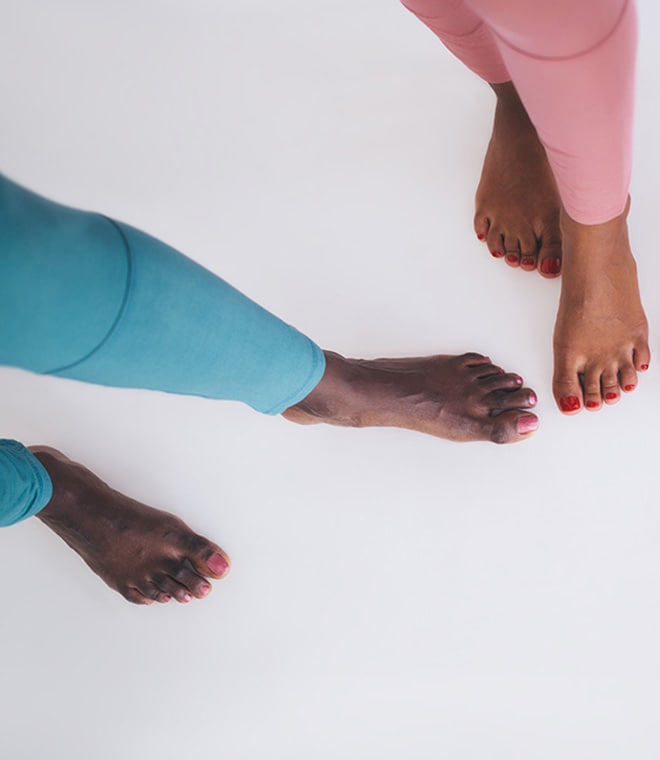Health
What are the causes of dark toenails?
By Anna H. Chacon, MD, Fellow of the American Academy of Dermatology Oct 18, 2024 • 5 min
Discoloration of the toenails, including dark spots or blackening nails, have a variety of different causes. While many cases of darkening toenails may not be serious, some may be signs of an underlying health condition. Here are some possible causes of dark toenails:
- Fungal infection: Discoloration on toenails is often the result of onychomycosis, a fungal infection that causes changes in the color and thickness of the toenails and may cause the nail to separate from the nail bed. Most fungal nail infections are caused by dermatophytes, which are microorganisms that thrive on a combination of keratin—the protein that makes up your skin, hair and nails—and moisture. Toenail fungal infections can cause the toenails to turn yellowish white or brownish black, and deep ridges may develop on the nail, or the affected nails may thicken. Various treatments, including over-the-counter antifungals, are available.
- Trauma: Toenail injury can result from stubbing your toe, wearing poorly fitting shoes, or participating in sports or activities that cause your nails to repeatedly hit the top of your shoe. This type of trauma may cause a purple or black toenail due to the pooling of blood from broken vessels (subungual hematoma).
- Cancer: Certain types of cancers and cancer treatments may cause discoloration of one or more nails. Sometimes the discoloration may appear as dark, irregular-shaped spots beneath the toenails. A type of skin cancer known as subungual melanoma may cause a dark streak to appear down the length of the nails. A darkening of the nail cuticle, called Hutchinson sign, may also occur if an aggressive type of melanoma is present. Blackening nails may also be a side effect of some types of cancer drugs and other medications, which can cause hyperpigmentation in part or all of the nail. Once treatment is complete, these dark areas typically go away on their own.
- Heavy metal poisoning: Silver poisoning and Wilson’s disease, which causes copper poisoning, are rare conditions that can cause one or more toenails to turn blue. This pigmentation may appear in a range of blue hues from blue-gray to slate-blue and may fade or be permanent.
- Bacterial infection: Green nail syndrome, also known as chloronychia, is a treatable condition caused by certain bacteria. The discoloration of the nail may appear bluish-green, bluish-gray or a darker shade of green. It can affect one or more nails and isn’t typically painful, although the area around the toenail may be tender or red.
- Infective Endocarditis: Vertical red or purple toenail lines that appear under the nail bed may be an indication of heart disease. These nail discolorations are known as splinter hemorrhages because they appear as though a splinter is lodged under the nail. When it’s a sign of a condition called infective endocarditis, this nail condition is usually—but not always—accompanied by a fever or a weak or irregular heartbeat.
- Kidney disease: Half and half nails, also known as Lindsay’s nails, may be an indication of chronic kidney disease. It’s characterized by nails that have two distinct discolorations—the bottom part of the nail near the cuticle appears white, and the top portion appears brownish-red. Half and half nails may also occur in people who have other systemic conditions like Crohn’s disease and cirrhosis.
When to see your dermatologist about dark toenails
Black spots or other discolorations from a toenail injury may resolve without medical help. However, people with diabetes should see their healthcare provider if they injure their toe or develop a fungal infection of the toenail, as these issues can become more serious due to impaired healing. You should see your healthcare provider to rule out any possible serious conditions if your toenail color changes suddenly without explanation, especially if you have darker skin or pain accompanies the darkening of the nails.
Updated by Julie McDaniel, MSN, RN, CRNI, October 2024.
Sources:
- https://www.aafp.org/afp/2013/1201/p762.html
- https://medlineplus.gov/ency/article/003247.htm
- https://www.cancer.org/treatment/treatments-and-side-effects/physical-side-effects/nail-changes.html
- https://www.cdc.gov/diabetes/diabetes-complications/diabetes-and-your-feet.html
- https://www.aad.org/public/diseases/a-z/heart-disease-warning-signs
- https://www.aocd.org/page/GreenNailSyndrome
- https://www.aafp.org/afp/2004/0315/p1417.html
- https://www.ncbi.nlm.nih.gov/pmc/articles/PMC4945547/
- https://medlineplus.gov/ency/patientinstructions/000800.htm
- https://www.merckmanuals.com/home/skin-disorders/nail-disorders/fingernail-and-toenail-injury
- https://www.uptodate.com/contents/overview-of-nail-disorders
- https://www.aad.org/public/everyday-care/nail-care-secrets/basics/nail-changes-dermatologist-should-examine
- https://www.merckmanuals.com/home/skin-disorders/nail-disorders/deformities-dystrophies-and-discoloration-of-the-nails
- https://www.merckmanuals.com/professional/dermatologic-disorders/nail-disorders/nail-trauma
- https://rarediseases.org/rare-diseases/heavy-metal-poisoning/
- https://www.ncbi.nlm.nih.gov/books/NBK441990
- https://www.ncbi.nlm.nih.gov/pmc/articles/PMC9421492/
- https://www.mayoclinicproceedings.org/article/S0025-6196(22)00040-4/fulltext



